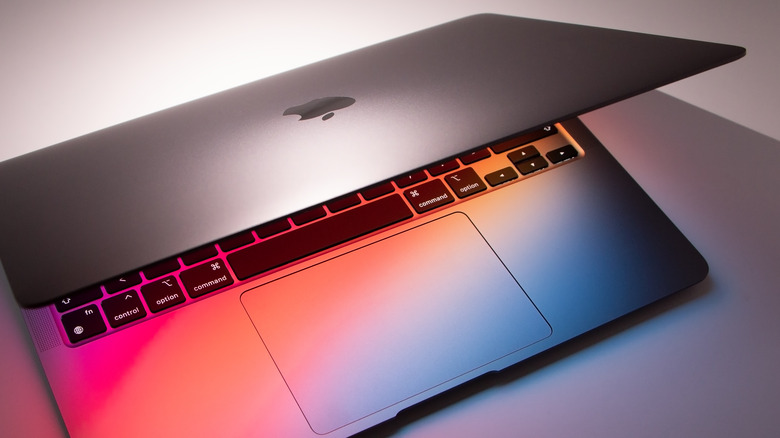How To Turn Your Old MacBook Into An Emergency Wi-Fi Hotspot
If you've heard of Wi-Fi hotspots before, chances are you're most familiar with using a smartphone as one. These spontaneous internet setups can be a huge help when you find yourself in need of an internet connection for your laptop when there isn't one — or at least not one you have access to — available. They may not be very necessary if you have a decent wireless internet connection at home, but they can come in handy when you find yourself in internet-deficient territory.
The entire point of a Wi-Fi hotspot is to open up your cellular data connection to other devices. It allows you to control when the connection is active and who can connect, but any online activity will count towards your data plan's limits if you have one. Keep that in mind if you have to upload or download a lot of data, because extending beyond your plan's limits could result in slower performance or additional fees being tacked onto your cellular bill at the end of the month.
Why you should use your MacBook as a Wi-Fi hotspot
Turning your MacBook into a Wi-Fi hotspot isn't exactly the same as using a phone. Since MacBooks don't currently offer cellular connections, the only way for you to connect them to the internet (and by extension, offer that internet to other devices) is to already have an internet connection available. Seems counter-intuitive, right? But there are some situations where setting up a MacBook Wi-Fi hotspot could be useful.
For instance, this feature is handy if you're in a location that doesn't normally have Wi-Fi but does offer a physical ethernet connection. Most pocket-sized devices that can connect to the internet (i.e., smartphones) can't just plug into an ethernet cable, and if you have more than one ethernet-capable device you need to get online with, a single connection won't cut it. By plugging in your old MacBook and setting it up to share Wi-Fi, you're effectively making it a temporary wireless router that your other devices can connect to.
What you need in order to use a MacBook as a Wi-Fi hotspot
Turning your MacBook into a Wi-Fi hotspot isn't very difficult, but there's more to it than simply clicking a button. Your MacBook will need to be running macOS 10.6 Snow Leopard at the very least, as that's when Apple began including Internet Sharing options. You'll also want to make sure your MacBook can access the available internet connection, whether that means having the necessary ethernet connections or knowing the access password (if there is one). After all, this feature won't do you much good if it can't get online in the first place.
Lastly, you may want to take additional steps to secure your connection. If you expect to be sending or receiving sensitive information, consider setting up a VPN to better protect your online privacy. At the very least, it's highly recommended that when you're setting up your shared internet connection, you choose a more secure option like WPA2 or WPA3.
How to set up a MacBook Wi-Fi hotspot
The first step to setting up your MacBook as a Wi-Fi hotspot is to enable Internet Sharing in macOS. The process may differ slightly depending on the version of macOS you're using, but for the most part, it goes like this:
- Open System Preferences.
- Select Sharing > Internet Sharing.
- Choose the proper source device under "Share your connection from."
- Select how you want to share in the "To computers using" section.
Where things get a bit more nuanced is when you're deciding how to share your connection. If you're planning on sharing via Wi-Fi, when you get to Step 3 you'll want to choose Ethernet, then choose Wi-Fi for Step 4. After that open Wi-Fi Options to set up your connection details (name, security, password, etc.), then select Start to begin sharing your connection.
If you're using a Wi-Fi adapter, you'll want to get it configured first (this will depend on your provider), then select the Wi-Fi adapter in Step 3. The rest of the process is the same as it is for a regular Wi-Fi setup.
What about Bluetooth?
It is possible to share your MacBook's internet connection wirelessly through Bluetooth, but it's not ideal, mostly because Bluetooth internet connections aren't as fast as Wi-Fi and the range is much more limited. However, it will work in a pinch, so if it's your only option, it can still get the job done. First, make sure Bluetooth is available and enabled on both your MacBook and the device you want to connect to it.
- Open System Preferences on your MacBook.
- Select Sharing > Internet Sharing.
- Select the proper source device under "Share your connection from."
- Choose Bluetooth PAN as the sharing method.
- Select Internet Sharing > Start to begin sharing.
Keep in mind that not all MacBooks support Bluetooth PAN, especially newer models, as Wi-Fi has become so ubiquitous. If your MacBook doesn't offer Bluetooth PAN, you'll have to choose Wi-Fi instead, and if your device can't connect to Wi-Fi, you might have to find another way to transfer the necessary materials to your MacBook altogether.




